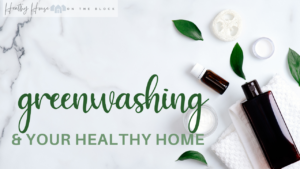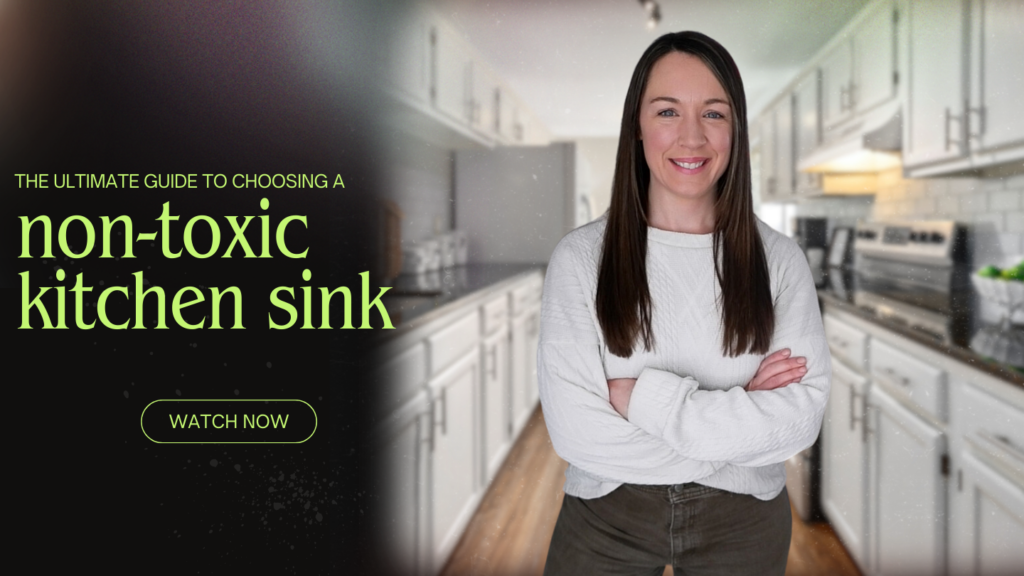
On every single one of my kitchen remodel projects, the topic of the kitchen sink becomes a huge focus.
But in truth, it’s often a component that my clients have never considered until we sit down.
Can you relate? Have you ever thought about potential toxins in your kitchen sink material?
Most of us don’t, which makes total sense.
Why would there be toxins in such a frequently used material inside our homes?
Afterall, we’ve been led to believe that our homes are toxin free until proven otherwise.
Well I’m here to tell you there are in fact potentially toxic kitchen sink materials that you can STILL choose in your remodel. I wish people were more aware that there are STILL toxic kitchen sinks being manufactured today.
But with the right information and knowledge about healthier kitchen sink materials, you can make the right decision and avoid bringing unnecessary toxins into your space.
So whether you’re in the midst of a remodel, new build or just planning ahead, this information about kitchen sinks – the good and the bad — will hep you make your decision as you work towards your own healthier home.
When Is It Time to Replace Your Kitchen Sink?
Making the switch to a toxin-free sink is an important step toward a healthier home, but timing this project thoughtfully can make a huge difference in both its success and your stress levels. Let’s look at the key factors to consider when planning your sink replacement.
Signs Your Current Sink Needs Attention
Your current sink might be telling you it’s time for a change if:
- The surface is deeply scratched or pitted, creating spots for bacteria to grow
- You notice discoloration or rust, especially around the drain area
- There’s visible damage to the coating or finish
- You can smell musty odors even after thorough cleaning
- The material is wearing down and releasing particles
- You’ve discovered your current sink contains materials you’re trying to eliminate from your home
Financial Planning
Creating a healthy home doesn’t mean you need to strain your budget. Consider these financial aspects:
- Set aside money specifically for your sink project before starting
- Include extra funds for unexpected issues (about 20% of your budget)
- Look for seasonal sales from reliable suppliers
- Consider the long-term value – a quality toxin-free sink might cost more upfront but can last decades
- Factor in all costs: sink, fixtures, installation materials, and labor
- Remember that some credit cards offer cashback on home improvement purchases
Project Timing
The best time to replace your sink is when you can:
- Take time to thoroughly research materials and installers
- Order samples and visit showrooms without rushing
- Have flexibility in case of shipping delays
- Plan for 2-3 days without a working kitchen sink
- Coordinate with a trusted installer’s schedule
- Make thoughtful decisions rather than emergency ones
Resource Availability
Before starting your project, ensure you have:
- Access to qualified installers who understand toxin-free materials
- A clear source for all your materials and supplies
- Storage space for your new sink and materials before installation
- A backup plan for kitchen tasks during the replacement
- Help with heavy lifting and installation if needed
- A clear understanding of your plumbing system
Emergency vs. Planned Replacement
While sometimes sink replacement becomes urgent due to leaks or damage, whenever possible, opt for a planned replacement. A planned project allows you to:
- Source the healthiest materials without rushing
- Compare options and prices
- Choose the best available installer
- Prepare your space properly
- Minimize your family’s exposure to construction materials
- Create a temporary kitchen setup if needed
Creating Your Timeline
A well-planned non toxic kitchen sink replacement is key to making the whole process healthy and as stress free as possible. Here’s an idea of what that might look:
- Research Phase (1-2 months):
- Investigate materials
- Read reviews
- Get material samples
- Research installers
- Planning Phase (2-4 weeks):
- Finalize material choices
- Order samples
- Get installation quotes
- Plan your temporary kitchen setup
- Preparation Phase (1-2 weeks):
- Order materials
- Schedule installation
- Clear under-sink area
- Purchase necessary cleaning supplies
- Installation Phase (2-3 days):
- Remove old sink
- Install new sink and fixtures
- Allow caulk and sealants to cure
- Test thoroughly before full use
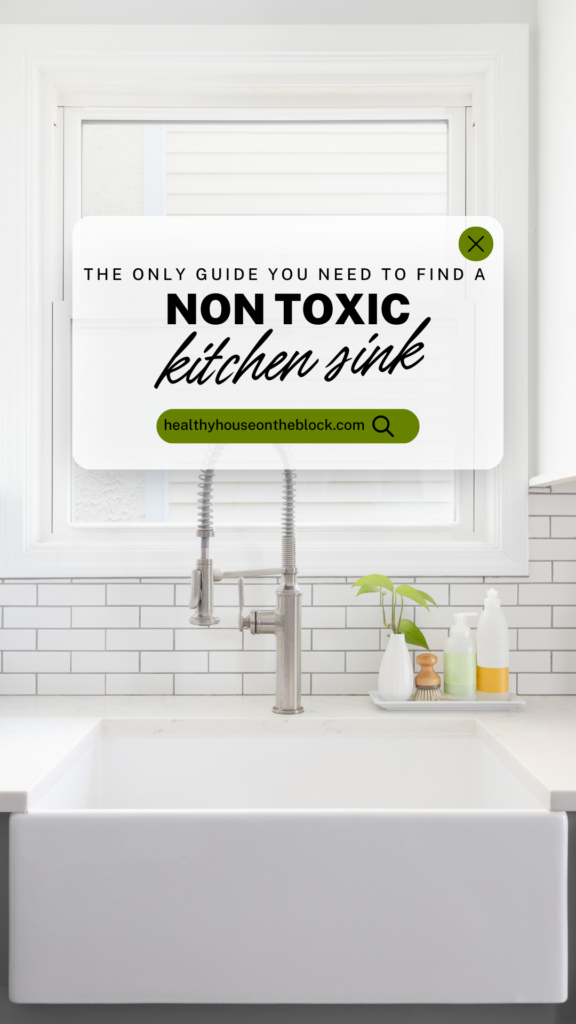
Materials to Avoid in Kitchen Sinks
It’s hard to imagine that even today there are kitchen sinks being sold that are toxic to our health and wellness. I think most of us are shocked when we learn about this. But this is why it’s SO important to pay attention to what healthy materials you should be looking for when it comes to non toxic kitchen sinks. Here are some of the materials you want to avoid:
Composite and Granite-Look Sinks
While these might look like stone, they’re actually made with a mix of acrylic resins and crushed stone particles. Most of the time these sinks are touted as super durable, but they have some serious health risks. These synthetic materials can:
- Hormone Disruptors: These sinks contain BPA and other endocrine-disrupting chemicals (SOURCE)
- Microplastic Exposure: As they wear down over time, they will release microplastics as it is used.
- Leach Chemicals: when exposed to hot water or acidic foods, the composite material can leach toxins and chemicals into its surface area.
- Heat Sensitivity: The acrylic resin component can be sensitive to extreme temperatures. Placing hot pots or pans directly into the sink may cause the resin to warp or melt, potentially releasing harmful substances. SOURCE
- Chemical Emissions: Some composite materials may emit volatile organic compounds (VOCs) during manufacturing or if exposed to high heat. These emissions can contribute to indoor air pollution and may pose health risks over prolonged exposure.
Engineered Stone Materials
Engineered stone, often used for countertops and sometimes for sinks, is composed of crushed stone bound together by adhesives, primarily resins. A significant health concern associated with these materials is:
- Silica Dust Exposure: Cutting or processing engineered stone can release fine silica dust particles into the air. Inhalation of silica dust is linked to silicosis, a severe and incurable lung disease. Due to rising cases of silicosis among workers handling these materials, some countries have implemented bans or strict regulations on engineered stone products. SOURCE
Enameled Cast Iron
While traditional and beautiful, many enameled sinks contain concerning materials:
- The enamel coating often contains heavy metals for coloring
- Some older models may contain lead in the glaze
- Chips and scratches can expose the underlying iron, leading to rust and potential contamination
Generally, the main concern for enameled cast iron is when the sink is older, but there are even newer kitchen sinks that can contain some to the heavy metal concerns in the glaze and coloring. Finding products that are made and manufactured in the USA is usually the best course of action.
Low-Grade Stainless Steel
Not all stainless steel is created equal. And while I think we all would think that stainless steel is a GREAT and non toxic kitchen sink option, the truth is it may not be. Lower-grade options can:
- Contain higher levels of nickel that can leach into water
- Break down more quickly, especially with acidic foods
- Release metal particles as they wear down(National Institute of Environmental Health Sciences studies on metal leaching)
.
Non Toxic Sink Options
Fireclay Sinks: The Ceramic Champion
Fireclay sinks are made from natural materials – primarily clay and porcelain – fired at extremely high temperatures. These sinks are incredibly durable and completely inert, meaning they won’t leach any chemicals into your water. The smooth, non-porous surface also prevents bacteria growth, making them an excellent choice for health-conscious families.
Benefits:
- Made from natural materials
- Zero chemical leaching
- Extremely durable and scratch-resistant
- Naturally antimicrobial surface
- Heat resistant up to 2500°F
Fireclay: A durable and non-toxic material, fireclay sinks are heat-resistant and offer a classic aesthetic. SOURCE
High-Quality Stainless Steel: The Pure Option
When choosing stainless steel, look for medical-grade 316 stainless steel (also called surgical steel). While 304-grade is common, 316 offers superior corrosion resistance and better for corrosion protection from cleaners and minerals. (If you need nickel free, 430 stainless steel is free from that metal, making it ideal for families with metal sensitivities).
Benefits:
- Naturally antibacterial
- No harmful chemical treatments
- Extremely durable
- Won’t absorb odors or flavors
- Easy to maintain without harsh cleaners
(Stainless Steel: Despite concerns about chromium, high-quality stainless steel remains a favored material for sinks due to its robustness and ease of maintenance. SOURCE
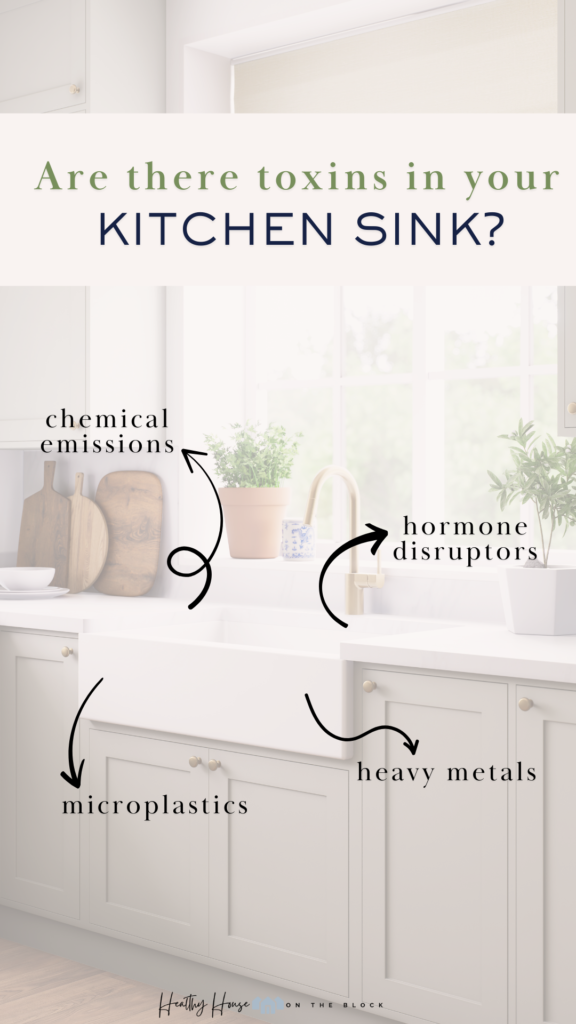
Copper Sinks: Nature’s Antimicrobial
While copper sinks do require more maintenance, they offer unique health benefits. Copper has natural antimicrobial properties that can actually kill harmful bacteria. When choosing a copper sink, look for one that’s at least 99% pure copper without additional metals or coatings.
Benefits:
- Natural antimicrobial properties
- Ages beautifully with a natural patina
- No toxic chemicals or treatments
- Naturally inhibits bacterial growth
- Can last for generations with proper care
Copper: Known for its natural antimicrobial properties, copper sinks can reduce bacteria buildup, contributing to a healthier kitchen environment.
Stone Sinks: Pure and Timeless
Natural stone sinks, particularly those made from granite or soapstone, offer another toxin-free option. These materials are completely natural and, when properly sealed with non-toxic sealants, provide a beautiful and safe surface for your kitchen.
Benefits:
- Made from pure, natural stone
- No artificial materials or chemicals
- Extremely durable
- Heat resistant
- Each piece is unique
- Won’t off-gas like synthetic materials
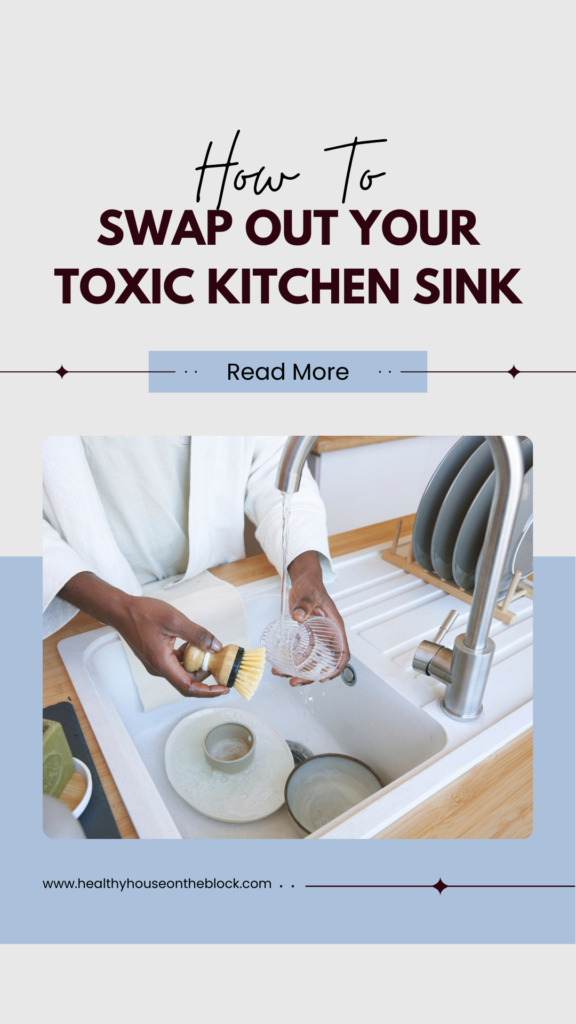
Healthy Installation Practices
Creating a truly toxin-free sink setup goes beyond just choosing the right sink material. Here’s how to ensure a healthy installation:
Toxin-Free Caulk and Sealants (check out this post for my favorite toxin free options)
Choose:
- Pure silicone caulk free from antimicrobial additives
- Low-VOC or zero-VOC sealants (look for GreenGuard certification)
- Natural stone sealers made with food-grade materials
- Water-based adhesives instead of solvent-based options
Avoid:
- Traditional silicone caulk with antimicrobial chemicals
- Polyurethane-based sealants
- Synthetic polymer-based products
- Any products containing phthalates or formaldehyde
Plumbing Considerations (this post will show you how to find a lead free faucet)
- Use lead-free brass or stainless steel fittings
- Choose PVC-free pipes like copper or PEX-a
- Install water-hammer arrestors made from safe materials
- Use food-grade plumber’s tape for connections
Under-Sink Setup
- Install a moisture barrier made from natural materials
- Use formaldehyde-free cabinet materials
- Choose stainless steel or copper drain pipes instead of PVC
- Install a non-toxic water filter system
Installation Tips
- Ventilate the space well during and after installation
- If any products need to be cut, ask if they can cut materials outside the home
- Allow all sealants to fully cure before use
- Consider hiring a contractor who specializes in non-toxic installations
- Request that installers use low-VOC or natural cleaning products during setup
- Clean area thoroughly when finished to remove any dust and debris that can get spread through your home
Maintenance Products
Keep your sink toxin-free long-term by using:
- Natural cleaning solutions like vinegar and baking soda
- Pure castile soap for daily cleaning
- Food-grade hydrogen peroxide for disinfecting
- Organic cloths natural brushes instead of synthetic sponges
- Natural stone cleaners for stone sinks
- Pure beeswax or carnauba wax for copper maintenance
Remember, a truly healthy kitchen sink installation isn’t just about the sink itself – it’s about every material that goes into making it functional. Taking the time to source safe materials and work with knowledgeable installers will ensure your new sink contributes to your home’s healthy environment rather than detracting from it.
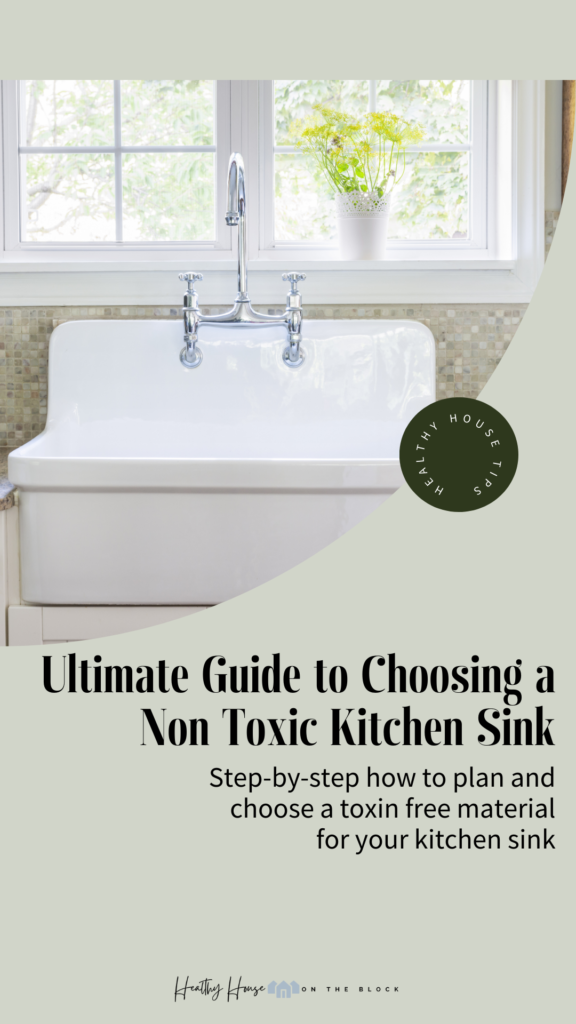
Creating a healthy home is a journey, not a race. While it might be tempting to rush into a replacement when you learn about toxins in your current sink, taking time to plan thoroughly will result in a healthier installation and less stress for your family.
Share this:
- Click to share on Facebook (Opens in new window) Facebook
- Click to share on LinkedIn (Opens in new window) LinkedIn
- Click to share on Reddit (Opens in new window) Reddit
- Click to share on Pinterest (Opens in new window) Pinterest
- Click to print (Opens in new window) Print
- Click to share on X (Opens in new window) X




